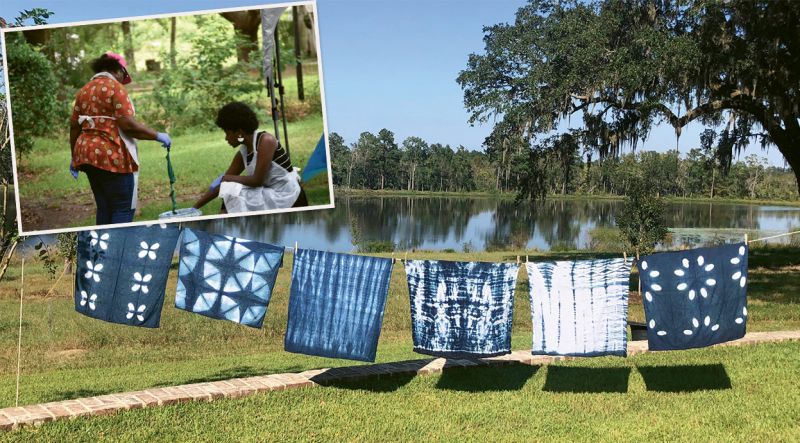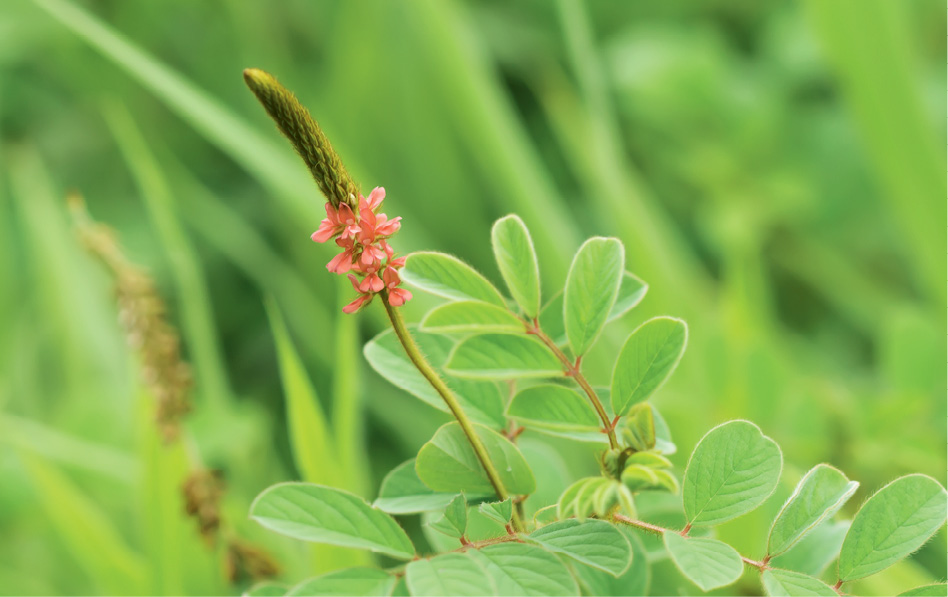A new nonprofit is raising awareness about indigo—its role in South Carolina history as well as potential entrepreneurial opportunities for growers, dye producers, and artisans

(Above) Freshly designed textiles dry after a workshop held by CHI Design Indigo. (Inset) As part of its “All About Indigo” series, Charleston County Public Library held a hands-on event at the McClellanville branch; Bria Graham of the Gullah Geechee Cultural Heritage Corridor Commission kneels at the dye bucket.
Across the Lowcountry, pockets of indigo plants grow: in a garden at the John’s Island Regional Library, in Middleton Place fields, in farmers’ private plots. Artisans are transforming the green leaves into blue dyes; artists are using the dyes to create yarns, wearables, paintings, and more. And the International Center for Indigo Culture (ICIC) is connecting them all, while pulling the public into their circle. “We’re raising awareness about indigo—its role in South Carolina history, but also the fact that it presents entrepreneurial opportunities for the future: for growers, dye producers, and artists,” explains board member David Harper, who assists his wife, Caroline, in operating CHI Design Indigo.
A Who’s Who of indigo creatives converge at ICIC’s helm: Arianne King Comer, Heather Powers, and Donna Hardy. It was Hardy who founded the nonprofit three years ago, shortly after leaving the Holy City to move back to her native Georgia (read Charleston’s 2014 profile of her, “The Indigo Girl”).
In August, the ICIC began working with the Gullah Geechee Cultural Heritage Corridor Commission, participating in a panel discussion exploring the plant’s past in South Carolina. Indigo joined rice as the state’s major cash crop from 1744 to 1774, and “That was largely due to knowledge and skills possessed by enslaved people—ancestors of the Gullah Geechee,” notes the commission’s executive director, Heather Hodges. During the event, she also “talked about the significance of indigo—and, more largely, the color blue—in Gullah Geechee culture as an extension of the way it’s been used in West Africa for centuries.”
To share more of that history, the nonprofits are partnering with the John’s Island Regional Library on an indigo workshop on November 5. While dyeing a head wrap or handkerchief, King Comer hopes attendees “gain a sense of awe about the process and understanding of indigo’s importance locally and globally.” Learn more about the ICIC at internationalcenterforindigoculture.org.
The Hands-On Indigo Dye Workshop & Screening of Blue Alchemy: Stories of Indigo is November 5, from 2 to 3:30 p.m., at the John’s Island Regional Library, 3531 Maybank Highway. Register for the free program at Charleston County Public Library.

Want to Grow at Home? Here’s how to raise the historical plant—if you can get your hands on it
Indigofera suffruticosa is the variety of indigo most commonly grown in the Lowcountry during the 1700s, and it remains the most popular today. Shrubby with salmon-hued, pea-shaped flowers, “It’s honestly rather nondescript,” says Donna Hardy, “but I always say that it should be growing on every corner in Charleston because of its historical significance.”
The trouble is, no one’s selling it—seeds and plants are simply passed from gardener to gardener. If you don’t have any connections to play on, your best bet is to contact the International Center for Indigo Culture. The nonprofit hopes to collaborate with seed catalogues and nurseries over the next year and will spread the word as soon as there are opportunities to purchase.
To plant seeds in the fall, scatter them onto enriched soil in a sunny spot. Cover lightly with more soil and wait for a crop to emerge when the weather warms. Spring planting requires scarification: soak seeds in boiling water for one minute, then let them dry. Plant directly in the ground once soil temps reach about 75 degrees, and water daily until the seedlings are three inches tall.
Photographs (workshops-2) courtesy of the Gullah Geechee Cultural Heritage Corridor Commission